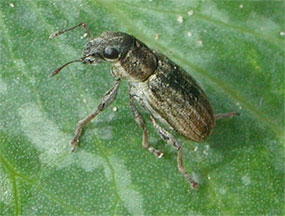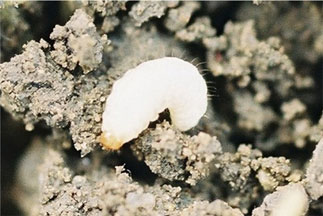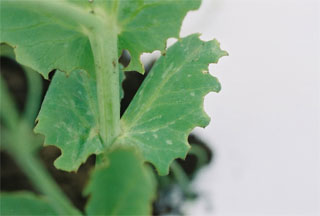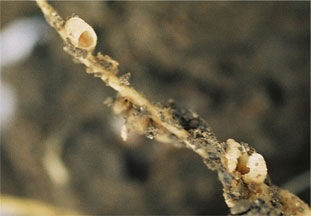| |
Pea Leaf Weevil | |
| |
|
|
| |
|
|
| | Background
Pea leaf weevil (Sitona lineatus) is an insect pest that feeds on the roots (larvae) and leaves (adults) of a wide range of cultivated and wild legume species. The pea leaf weevil (PLW) is native to Europe and was first identified in Alberta by Agriculture and Agri-food Canada entomologist Dr. Bob Byers. First record of this insect attacking peas in Alberta was in 2000 near Lethbridge, Alberta. Subsequent surveys have revealed considerable range expansion and increasing damage.
In southern Alberta peas are the major crop at risk of economically significant damage. PLW adults do feed on dry beans but the damage is usually minor. Fababeans are a preferred host but at this point most fababeans are not grown where PLW occurs in Alberta. Most losses result from larval feeding on nitrogen-fixing nodules. In extreme cases adults feeding on the leaves and growing point of seedlings can also cause economic damage.
Identification
The adult (Figure 1) is slender, greyish-brown and about 5 mm long. Adult PLW can be confused with the sweet clover weevil. PLW can be distinguished by the presence of three light-colored stripes extending length-wise down the thorax and sometimes the abdomen of the pea leaf weevil. Pea leaf weevil larvae are “C” shaped, light milky white in color with a dark brown head, legless, cylindrical, soft and fleshy and 3.5 to 5.5 mm in length (Figure 2).
 |  |  |
Figure 1. Adult Pea Leaf Weevil Adult
(photo: H. Goulet) |  | Figure 2. Pea Leaf Weevil Larva (photo: L. Dosdall) |
Distribution
Surveys for PLW have been conducted in Alberta since 2001. No measurements of PLW distribution have been made for Saskatchewan and Manitoba but it has not been noted in either of these provinces. In Alberta the pest occurs commonly in pea fields south of Highway #1 with density of the insect and resulting damage increasing towards Lethbridge.
Life cycle
Under Alberta conditions, the PLW produces one generation per year. Adult PLW over-winters in alfalfa or other perennial legumes. In the spring PLW moves primarily by flying (above 17oC) or they may walk short distances. The female lays 1000 to 1500 eggs in the soil near or on developing plants in May through June. Upon hatching larvae then move to the nodules where they feed. Larvae undergo 5 instars and feed on Rhizobium nodules then pupate in the soil. New adults emerge later in the growing season (late July through August) search for any pulse crops to continue feeding before overwintering.
Damage
Adult beetles feed on leaf margins and growing points of legume seedlings. Feeding on the leaf margins produces a characteristic scalloped (notched) appearance (Figure 4).
Larvae feed on the nitrogen-fixing nodules of legume species resulting in partial or complete inhibition of nitrogen fixation by the plant (Figure 5).
 |  |  |
| Figure 4. Pea Feeding Damage (photo: L Dosdall) |  | Figure 5. Larvae Feeding on Nodules (photo: L. Dosdall) |
For more information of pea leaf weevils and their management contact the Ag-Info Centre at 310-FARM (3276). |
|
| |
|
|
| |
For more information about the content of this document, contact Scott Meers.
This document is maintained by Shelley Barkley.
This information published to the web on May 2, 2007.
Last Reviewed/Revised on May 13, 2014.
|
|